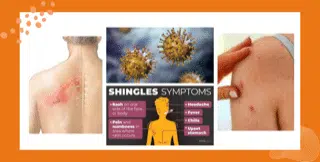Shingles and chickenpox are caused by the same virus, Varicella-zoster. Shingles is a reactivation of the chickenpox virus that can appear years after a person has had chickenpox. There is no known reason for the reactivation of the virus, but it is thought that a person with a weakened immune system is more likely to suffer from shingles. Other factors that may determine whether the Varicella virus get reactivated include individuals (who have previously had chickenpox) and who:
- Are age 50 and older
- Are under a lot of stress
- Have cancer or HIV
- Have had a serious physical injury
- Take long-term steroids or other medicines that can weaken your immune system
- Didn’t get the chickenpox vaccine as a child or adult
- Did not get the shingles vaccine as an adult
Shingles can occur anywhere on the body but most commonly causes a painful rash that wraps around the left or right side of the body. They can also appear around one eye or the side of your neck or face. The rash looks like a small cluster of bumps which can appear red on lighter skin or pink, gray, purple or brown on darker skin. The bumps will turn into fluid-filled blisters which will eventually crust and dry out within 7-10 days. Shingles can be spread to people who have never had chickenpox and have not been vaccinated. People with shingles are considered contagious until all sores have crusted over. Until that time, infected individuals should avoid pregnant women, those who have never had chickenpox, people with weakened immune systems and newborn babies.
Early symptoms of shingles can include:
- Enlarged lymph nodes
- Red rash
- Clusters of tiny blisters
- Pain, burning, tingling
- Itching
- Fever
- Headache
- Sensitivity to light
- Fatigue
Call your doctor if you have any of these symptoms, but it is urgent to see a physician if the shingles rash is near your eye. Unless treated properly, it could lead to permanent eye damage. Shingles can last from 2-6 weeks and most people only get it once, although it is possible to have shingles more than once.
There is currently no cure for shingles, but it can be treated effectively with oral antibiotics such as Acyclovir (zovirax), Famciclovir, and Valacyclovir (Valtrex). Other treatments include anticonvulsant medication (Neurontin), cool compresses, medicated lotion, numbing medications, over-the-counter painkillers such as ibuprofen/acetaminophen, or prescription drugs such as codeine. Getting the childhood chickenpox vaccine or the adult shingles vaccine is one way to reduce your risk of contracting shingles. The CDC currently recommends the Shingrix vaccine as a proactive way to avoid shingles infection. Shingrix is believed to be greater than 90% effective with a recommended two-shot dosage to adequately prevent shingles and its complications. People should be vaccinated against the shingles virus before actually contracting shingles. Before 2020, Zostavax was the recommended vaccine for shingles. However, it was removed from the market in 2020 and is no longer considered an effective preventative treatment. If you have previously been vaccinated with Zostavax, you should consider updating the vaccine with Shingrix.
The most common complication from shingles is pain that lasts long after the outbreak, called postherpetic neuralgia. It affects 1 in 5 people who contract shingles. Acupuncture is considered an effective way to relieve shingles pain in addition to preventing or alleviating potential long-term effects like postherpetic neuralgia. “Researchers from three independent studies conclude that acupuncture and herbal medicine significantly relieve rashes and pain associated with the herpes zoster virus (shingles). Importantly, acupuncture and herbal medicine outperformed antiviral and anti-inflammatory medications, indicating that usual care protocols are suboptimal without inclusion of acupuncture and herbal medicine.”1 Clinically, we’ve also found ozone therapy helpful in reducing the pain and inflammation associated with shingles and speeding healing time. If you’re suffering with postherpetic neuralgia, don’t wait to receive treatment.
Sources:
- https://www.healthcmi.com/Acupuncture-Continuing-Education-News/1908-acupuncture-and-herbs-stop-shingles-pain-outperforms-drugs
- https://www.mayoclinic.org/diseases-conditions/shingles/symptoms-causes/syc-20353054
- https://www.webmd.com/skin-problems-and-treatments/shingles/shingles-skin
- https://www.welleum.com/ease-shingles-pain-with-these-tcm-treatments/
- https://www.healthcmi.com/Acupuncture-Continuing-Education-News/1908-acupuncture-and-herbs-stop-shingles-pain-outperforms-drugs
- https://www.ncbi.nlm.nih.gov/pmc/articles/PMC7676539/

